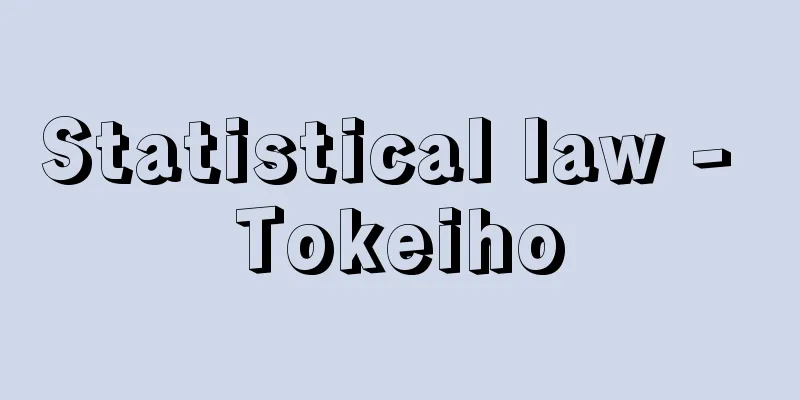Statistical law - Tokeiho

|
This law aims to ensure the systematic and efficient development and usefulness of official statistics by prescribing basic matters concerning the compilation and provision of official statistics, thereby contributing to the sound development of the national economy and the improvement of people's lives. Law No. 53 of 2007. It was promulgated in May 2007 and fully implemented in April 2009. Here, official statistics refers to statistics produced by national administrative agencies and local governments. In addition to statistics produced by statistical surveys (survey statistics), statistics produced by aggregating operational data (operational statistics) and statistics produced by processing other statistics (processed statistics) also fall under the category of official statistics. The Statistics Act prescribes the creation of a "basic plan for the development of official statistics" (a roadmap for specific initiatives spanning roughly five years). This provision is intended to ensure that official statistics are developed systematically and efficiently, given the limitations of budgets and personnel. In addition, statistics of particular importance designated by the Minister of Internal Affairs and Communications are positioned as "core statistics," and the official statistics are to be systematically developed with these core statistics at the center. Furthermore, with regard to statistical surveys conducted by national administrative agencies, it prescribes that the Minister of Internal Affairs and Communications will review and adjust statistical surveys, with the aim of eliminating duplication between surveys and reducing the burden on individuals and businesses who respond to surveys, and of systematically developing official statistics. While it is stipulated that information collected through statistical surveys (questionnaire information) must not be used or provided for purposes other than the original purpose of producing statistics, it is also stipulated that secondary use is possible only if it is used for public interest such as statistical research and education. Depending on the purpose of use, etc., the provisions include the provision of questionnaire information, custom-made compilation, and the provision of anonymous data. The current Statistics Act is sometimes called the New Statistics Act to distinguish it from the previous Statistics Act (Act No. 18 of 1947), which was enacted in 1947 and served as the basic law for statistical development for over 60 years. The main differences between the old and new Statistics Act can be summarized as follows: The first point is that it clearly states that statistics are public goods. The old Statistics Act did not clearly state who would receive the statistics, and so the statistics were essentially for the government. Second, the scope of official statistics is broadened to include survey statistics, operational statistics, and processed statistics compiled by national administrative agencies and local public organizations, etc. Under the old Statistics Act, the scope of the law was limited to survey statistics. Third, official statistics are now divided into important fundamental statistics and other general statistics, and the conditions for this division have been made clear. The old Statistics Act also had a framework for designated statistics and other statistics (approved statistics and notified statistics), but did not specify the selection criteria for the designated statistics. Fourth, it concretely indicates the systematic development of statistics, which was not clearly stated in the old Statistics Act. Fifth, the promotion of advanced use of statistical information, which is a public good, has been made clear in writing. Under the old Statistics Act, priority was given to the administrative use of statistics and the confidentiality of survey information, and there were strong restrictions on using survey information for purposes other than administrative purposes. [Nobuo Iizuka September 17, 2020] "Makoto Ato, "The Significance of the New Statistical Method" (Family Sociology Research, Vol. 21, No. 1, pp. 128-135, 2009, Japan Society of Family Sociology)" [Reference items] | | |Source: Shogakukan Encyclopedia Nipponica About Encyclopedia Nipponica Information | Legend |
|
公的統計の作成や提供に関し基本となる事項を定めることにより、公的統計の体系的かつ効率的な整備とその有用性の確保を図り、国民経済の健全な発展および国民生活の向上に寄与することを目的とする法律。平成19年法律第53号。2007年(平成19)5月に公布され、2009年4月から全面施行された。ここで、公的統計とは、国の行政機関・地方公共団体などが作成する統計をさす。統計調査により作成される統計(調査統計)のほか、業務データを集計することにより作成される統計(業務統計)や、他の統計を加工することにより作成される統計(加工統計)も公的統計に該当する。 統計法では、「公的統計の整備に関する基本的な計画」(おおむね5年にわたる具体的な取組みの工程表)を作成することを定めている。予算・人員に限りがあるなかで、公的統計を体系的・効率的に整備するための規定である。また、総務大臣が指定するとくに重要な統計を「基幹統計」として位置づけ、この基幹統計を中心として公的統計の体系的整備を図ることとしている。さらに、国の行政機関が行う統計調査については、調査間の重複を排除して調査に答える個人や企業の負担を軽減し、公的統計を体系的に整備する観点から、総務大臣が統計調査の審査・調整を行うことも定めている。 統計調査によって集められた情報(調査票情報)は、本来その目的である統計作成以外の目的のために利用・提供してはならないと定める一方で、統計の研究や教育など公益に資するために使用される場合に限り、二次的に利用することが可能であることも定めている。利用目的等に応じて、調査票情報の提供、オーダーメイド集計、匿名データの提供をあげている。 なお、現行の統計法は、1947年(昭和22)に制定され、60年余にわたって統計整備の基本法であった従前の統計法(昭和22年法律第18号)と区別するために、新統計法とよばれることもある。 旧統計法と新統計法のおもな違いとしては、以下の5点があげられよう。 第一は、統計は公共財であることを明示した点である。旧統計法では統計の受益者が明示されず、実質的には政府のための統計であった。 第二は、公的統計の範囲を国の行政機関・地方公共団体などが作成する調査統計、業務統計、加工統計と幅広くとらえた点である。旧統計法では、もっぱら調査統計を法律の対象としていた。 第三は、公的統計を重要な基幹統計とその他の一般統計に分けているが、その条件を明示したことである。旧統計法でも指定統計とその他の統計(承認統計と届出統計)という枠組みはあったが、指定統計の選定基準は示されていなかった。 第四は、統計の体系的整備について具体的に示したことである。旧統計法では明示されていなかった。 第五は、公共財である統計情報の高度利用の促進について明文化したことである。旧統計法では、統計の行政利用目的や調査情報の秘密保持が優先され、調査表情報を行政以外の目的に利用することに強い制限がかかっていた。 [飯塚信夫 2020年9月17日] 『阿藤誠「新統計法の意義」(『家族社会学研究』第21巻第1号所収・pp.128~135・2009・日本家族社会学会)』 [参照項目] | | |出典 小学館 日本大百科全書(ニッポニカ)日本大百科全書(ニッポニカ)について 情報 | 凡例 |
<<: Tokyo Dream Record - Toukeimukaroku
Recommend
Karunasundari - Karunasundari
…Bilhana was a Kashmiri Brahmin who studied the V...
Sunshine Rays
A railway line operated by JR East that connects U...
Book of regrets - Satamirensho
This is a guidebook on procedures, terminology, a...
Canvas difference - Canvas difference
…If the distance is greater than that, it is call...
Oi Gendo - Ooi Gendo
… [Pharmacognosy] The study of crude drugs is cal...
Shrine pilgrimage record
Written by Suzuka Katsura Tane (1795-1871), a prie...
Tsuruzo Ishii
Sculptor, Western-style painter, and printmaker. ...
Kanawatsugi
A type of joint used to connect the foundations an...
Medina - Medina (English spelling)
A religious city in northwestern Saudi Arabia. It...
Naples - Napoli (English spelling)
Naples is the capital of the Campania region in s...
Mogami [town] - Mogami
A town in Mogami District, northeastern Yamagata P...
Red Sarafan
...In the 19th century, this was consolidated int...
Garimomero tribe - Garimomero tribe
…(1) is often used in reference to the moon, is w...
teleprinter exchange
…It is also called TEX, TWX, or TLX, and in Japan...
Treaty of Tordesillas
A treaty signed in Tordesillas, Spain in 1494 betw...









